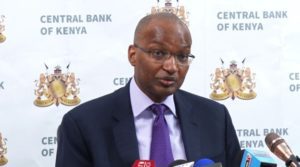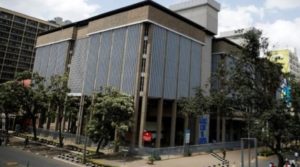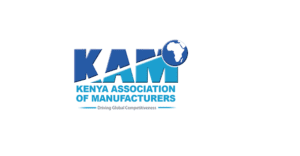The Governor of the Central Bank of Kenya (CBK) has challenged the claims that the continued United States Dollars shortages are leading to the appearance of a parallel exchange rate where the foreign currency is being purchased at figures that are significantly higher than the official rate.

Dr. Patrick Njoroge refuted the claims made by the Kenya Association of Manufacturers (KAM) that the scarcity in the supply of United States Dollars has resulted in its members having to buy the foreign currency at the rate of over 120 Kenyan Shillings per United States Dollar as opposed to the official Central Bank of Kenya (CBK) rate of 116.84 Kenyan Shillings per United States Dollar.
According to the Central Bank of Kenya (CBK) Governor, the foreign exchange market has enough United States Dollars to meet the demand from corporates and importers alike. In his words, “The [forex] market generates and distributes something like $2 billion every month. So if you have somebody or a sector which is importing $90 million or $100 million, I think that’s nowhere near the $2 billion that we are putting out there.”
He added that, “They should understand that they are small in that sense and sort of go to the market like everyone else. There are no favourites in the market. Follow the rules of the market and everything will be okay.”
Read Also: Interest Rate Increased By CBK To Combat Inflation
At the start of the week the Kenya Association of Manufacturers (KAM) requested that the Central Bank of Kenya (CBK) should “propose and implement policy actions” to make sure that the United States Dollars in the foreign exchange market will be enough to meet demand on time.

Mucai Kunyiha who is the Chairman of the Kenya Association of Manufacturers (KAM) stated that the imbalance the supply of the United States Dollar and its demand has gone on for a significant amount of time resulting in manufacturers purchasing the foreign currency at rates that are more expensive.
In the words of the Chairman, “This situation, compounded with the global challenges we are all facing, calls on the central bank and the Monetary Policy Committee to propose and implement policy actions that will return the market to predictability and, crucially, to supplies of currency as and when needed in order to restore confidence in the market.”
Although the Governor of the Central Bank of Kenya (CBK); Dr. Patrick Njoroge agreed that an increase in demand for United States Dollars is indeed the case in the market, he stated that it has now normalized.
Read Also: Central Bank Facing Pressure From Companies Over Dollar Crisis
In his words, “What’s clear is that …two months ago, there was significant, unusual demand [for dollars] maybe because of the dividend that were being paid out. That I think we all understood. But that whole season has ended and money has been transferred.”
He added that, “It’s a $2 billion per month market and that is significant. If you have an actor coming in looking for $1 million, $10 million or even $100 million and claims that it (market) is dysfunctional, then kazi kwako (it’s your work to find out why).”
In April of 2022 the Kenya Association of Manufacturers (KAM) revealed that banks in Kenya had placed certain limits on United States Dollar purchases which made it harder to purchase the necessary United States Dollars needed to obligations to suppliers and negatively affecting the ability to negotiate beneficial prices in spot markets.
A number of industrialists have had to purchase United States Dollars in advance as the continuous shortage in supply has threatened to have repercussions on the relationships with suppliers.

Dr. Patrick Njoroge stated that, “It’s interesting that some of the people that are writing to us don’t even have positions [and] they are not in the market. They are traders.”
According to the Governor of the Central Bank of Kenya (CBK), “If you go to the market and deal with the specific banks according to the rules of the market, [then] that means the banks, yourselves and indeed the dealers are aligned about how the markets operate. For you, as a customer, you don’t need to know the rules. Just go to the banks and present your information [on] what you are making the payments for, etcetera.”
The exchange rate situation has been a touchy subject for quite sometime in Kenya and a number of players privy to the situation prefer not to comment on the state of things for fear of repercussions from the Central Bank of Kenya (CBK).
Read Also: Parallel Exchange Rates Now Present In Kenya Due To Dollar Shortage
The Central Bank of Kenya (CBK) had in the past cautioned Stanbic Bank Kenya after a research released by its parent entities; Standard Bank in South Africa, states that a parallel exchange rate was beginning to exist in Kenya.
The occurrence resulted in Stanbic Bank Kenya having to issue a public statement where it clearly distanced itself from the research note released by Standard Bank of South Africa where it stated that, “two FX rates have been developing in the market.”
Stanbic Kenya made it known that, “The contents of the report do not reflect the position of Stanbic Bank Kenya Limited.”

The Kenya Association of Manufacturers (KAM) singled out the increase in costs of Crude Palm Oil, Fertilizer, Steel, and Iron all over the world as part of the major imports which have resulted in its members needing to purchase more United States Dollars.
The Kenya Association of Manufacturers (KAM) stated that the cost of one metric ton of crude Palm Oil which is used in the manufacturing of soaps, cooking oil, as well as cosmetic products with Glycerin went to almost three (3) times the previous cost going from 700 United States Dollars (which around 81,767 Kenyan Shillings) before the still ongoing Coronavirus pandemic began in March of 2020, to 1,980 United States Dollars (which is around 231,283 Kenyan Shillings) in March of 2022.
The Central Bank of Kenya (CBK) Governor stated that, “Of course, there has been other pressures from increase in price of oil and other products. And that is coming through, but the point is that can very well be taken care of by the market.”
Read Also: Central Bank Of Kenya Set To Take On A Bigger Role On Digital Payment Systems
As at the 26th of May 2022 the foreign exchange reserves for Kenya were at 8.177 billion United States Dollars (which is around 955 billion Kenyan Shillings). This is the equivalent of about 4.86 months of importation coverage. The current levels of foreign exchange reserves for Kenya are the lowest they’ve been since the 31st of March 2022 when they stood at 7.840 billion Kenyan Shillings which is around 4.66 months of importation coverage.
The foreign exchange reserves for Kenya are to a large extent being channeled towards the repayments of debt, as well as for the importation of government essentials like medicines.
According to the foreign exchange reserves released by the Central Bank of Kenya (CBK), said levels are still well above the country’s statutory requirement of four (4) months of importation coverage and 4.5 months cover for the East African Community bloc which is currently made up of seven (7) countries.
How informative was this particular article? Are there any other news topics, categories, or How To topics, that you would like us to write on? Feel free to reach out to Nexbit KE in the comment section.


